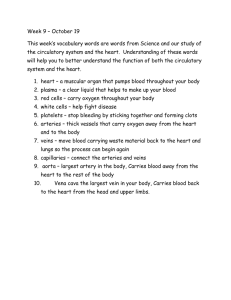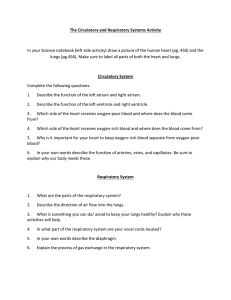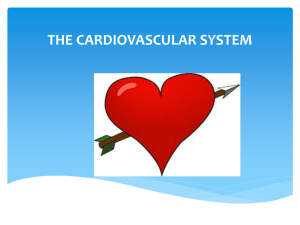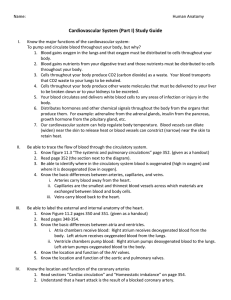3/26/2013
advertisement
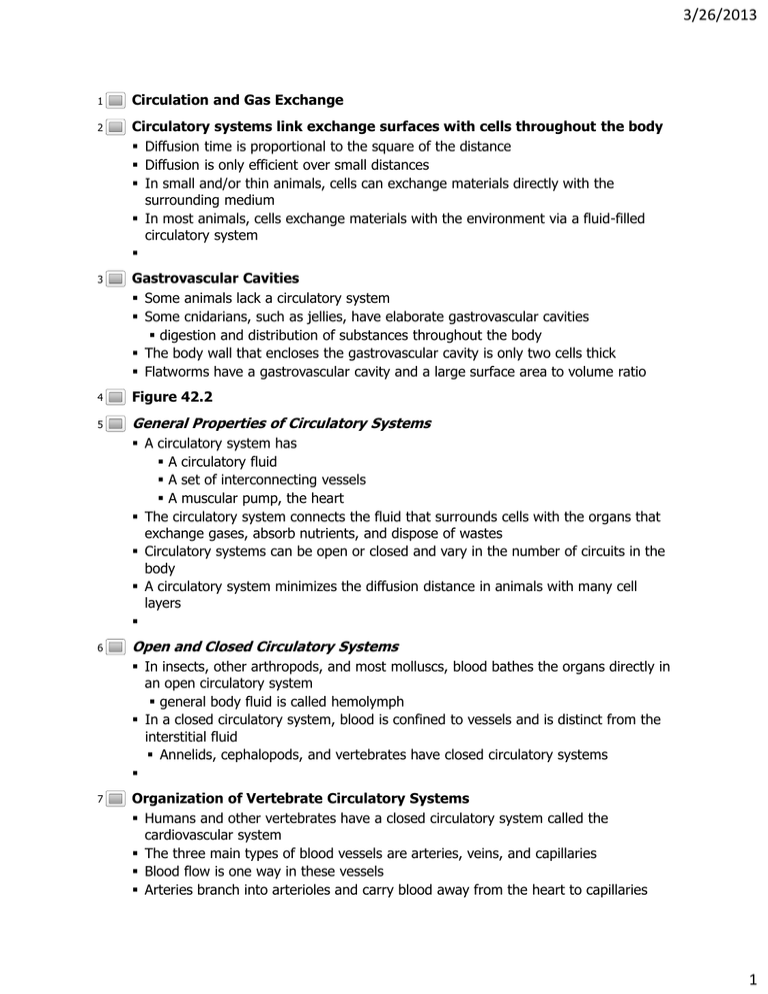
3/26/2013 1 Circulation and Gas Exchange 2 Circulatory systems link exchange surfaces with cells throughout the body Diffusion time is proportional to the square of the distance Diffusion is only efficient over small distances In small and/or thin animals, cells can exchange materials directly with the surrounding medium In most animals, cells exchange materials with the environment via a fluid-filled circulatory system 3 Gastrovascular Cavities Some animals lack a circulatory system Some cnidarians, such as jellies, have elaborate gastrovascular cavities digestion and distribution of substances throughout the body The body wall that encloses the gastrovascular cavity is only two cells thick Flatworms have a gastrovascular cavity and a large surface area to volume ratio 4 Figure 42.2 5 General Properties of Circulatory Systems A circulatory system has A circulatory fluid A set of interconnecting vessels A muscular pump, the heart The circulatory system connects the fluid that surrounds cells with the organs that exchange gases, absorb nutrients, and dispose of wastes Circulatory systems can be open or closed and vary in the number of circuits in the body A circulatory system minimizes the diffusion distance in animals with many cell layers 6 Open and Closed Circulatory Systems In insects, other arthropods, and most molluscs, blood bathes the organs directly in an open circulatory system general body fluid is called hemolymph In a closed circulatory system, blood is confined to vessels and is distinct from the interstitial fluid Annelids, cephalopods, and vertebrates have closed circulatory systems 7 Organization of Vertebrate Circulatory Systems Humans and other vertebrates have a closed circulatory system called the cardiovascular system The three main types of blood vessels are arteries, veins, and capillaries Blood flow is one way in these vessels Arteries branch into arterioles and carry blood away from the heart to capillaries Networks of capillaries called capillary beds are the sites of chemical exchange between the blood and interstitial fluid Venules converge into veins and return blood from capillaries to the heart 8 Single Circulation 1 Humans and other vertebrates have a closed circulatory system called the cardiovascular system The three main types of blood vessels are arteries, veins, and capillaries Blood flow is one way in these vessels Arteries branch into arterioles and carry blood away from the heart to capillaries Networks of capillaries called capillary beds are the sites of chemical exchange between the blood and interstitial fluid Venules converge into veins and return blood from capillaries to the heart 8 3/26/2013 Single Circulation Bony fishes, rays, and sharks have single circulation with a two-chambered heart In single circulation, blood leaving the heart passes through two capillary beds before returning 9 Double Circulation Amphibian, reptiles, and mammals have double circulation Oxygen-poor and oxygen-rich blood are pumped separately from the right and left sides of the heart 10 Amphibians three-chambered heart: two atria and one ventricle The ventricle pumps blood into a forked artery that splits the ventricle’s output into the pulmocutaneous circuit and the systemic circuit When underwater, blood flow to the lungs is nearly shut off 11 Reptiles (Except Birds) Turtles, snakes, and lizards have a three-chambered heart: two atria and one ventricle In alligators, caimans, and other crocodilians a septum divides the ventricle Reptiles have double circulation, with a pulmonary circuit (lungs) and a systemic circuit 12 Mammals and Birds Mammals and birds have a four-chambered heart with two atria and two ventricles The left side of the heart pumps and receives only oxygen-rich blood, while the right side receives and pumps only oxygen-poor blood Mammals and birds are endotherms and require more O2 than ectotherms 13 Figure 42.5c 14 Coordinated cycles of heart contraction drive double circulation in mammals Blood begins its flow with the right ventricle pumping blood to the lungs In the lungs, the blood loads O2 and unloads CO2 Oxygen-rich blood from the lungs enters the heart at the left atrium and is pumped through the aorta to the body tissues by the left ventricle The aorta provides blood to the heart through the coronary arteries Blood returns to the heart through the superior vena cava (blood from head, neck, and forelimbs) and inferior vena cava (blood from trunk and hind limbs) The superior vena cava and inferior vena cava flow into the right atrium 15 16 Figure 42.6 17 The heart contracts and relaxes in a rhythmic cycle called the cardiac cycle The contraction, or pumping, phase is called systole The relaxation, or filling, phase is called diastole 2 Blood returns to the heart through the superior vena cava (blood from head, neck, and forelimbs) and inferior vena cava (blood from trunk and hind limbs) The superior vena cava and inferior vena cava flow into the right atrium 3/26/2013 15 16 Figure 42.6 17 The heart contracts and relaxes in a rhythmic cycle called the cardiac cycle The contraction, or pumping, phase is called systole The relaxation, or filling, phase is called diastole The heart rate, also called the pulse, is the number of beats per minute The stroke volume is the amount of blood pumped in a single contraction The cardiac output is the volume of blood pumped into the systemic circulation per minute and depends on both the heart rate and stroke volume 18 Four valves prevent backflow of blood in the heart The atrioventricular (AV) valves separate each atrium and ventricle The semilunar valves control blood flow to the aorta and the pulmonary artery 19 The “lub-dup” sound of a heart beat is caused by the recoil of blood against the AV valves (lub) then against the semilunar (dup) valves Backflow of blood through a defective valve causes a heart murmur 20 Figure 42.9-1 21 Figure 42.9-2 22 Figure 42.9-3 23 Figure 42.9-4 24 Pacemaker regualtion Nervous System Control The sympathetic division speeds up the pacemaker The parasympathetic division slows down the pacemaker The pacemaker is also regulated by hormones and temperature 25 Patterns of blood pressure and flow reflect the structure and arrangement of blood vessels 26 Figure 42.11 27 Changes in Blood Pressure During the Cardiac Cycle Systolic pressure is the pressure in the arteries during ventricular systole; it is the highest pressure in the arteries Diastolic pressure is the pressure in the arteries during diastole; it is lower than systolic pressure A pulse is the rhythmic bulging of artery walls with each heartbeat Blood pressure is determined by cardiac output and peripheral resistance due to constriction of arterioles Vasoconstriction is the contraction of smooth muscle in arteriole walls; it increases blood pressure Vasodilation is the relaxation of smooth muscles in the arterioles; it causes blood pressure to fall 3 A pulse is the rhythmic bulging of artery walls with each heartbeat Blood pressure is determined by cardiac output and peripheral resistance due to constriction of arterioles Vasoconstriction is the contraction of smooth muscle in arteriole walls; it increases blood pressure Vasodilation is the relaxation of smooth muscles in the arterioles; it causes blood pressure to fall 28 3/26/2013 Figure 42.12 29 Fainting is caused by inadequate blood flow to the head Animals with longer necks require a higher systolic pressure to pump blood a greater distance against gravity Blood is moved through veins by smooth muscle contraction, skeletal muscle contraction, and expansion of the vena cava with inhalation One-way valves in veins prevent backflow of blood 30 Figure 42.14 31 Figure 42.15 32 Fluid Return by the Lymphatic System The lymphatic system returns fluid that leaks out from the capillary beds Fluid, called lymph, reenters the circulation directly at the venous end of the capillary bed and indirectly through the lymphatic system The lymphatic system drains into veins in the neck Valves in lymph vessels prevent the backflow of fluid Lymph nodes are organs that filter lymph and play an important role in the body’s defense Edema is swelling caused by disruptions in the flow of lymph 33 Figure 42.16 34 Figure 42.17 35 Leukocytes There are five major types of white blood cells, or leukocytes: monocytes, neutrophils, basophils, eosinophils, and lymphocytes They function in defense by phagocytizing bacteria and debris or by producing antibodies They are found both in and outside of the circulatory system 36 Blood Clotting Coagulation is the formation of a solid clot from liquid blood A cascade of complex reactions converts inactive fibrinogen to fibrin, forming a clot A blood clot formed within a blood vessel is called a thrombus and can block blood flow 37 Figure 42.19 38 Gas exchange occurs across specialized respiratory surfaces Gas exchange supplies O2 for cellular respiration and disposes of CO2 A gas diffuses from a region of higher partial pressure to a region of lower partial pressure Partial pressure is the pressure exerted by a particular gas in a mixture of gases Gases diffuse down pressure gradients in the lungs and other organs as a result of differences in partial pressure 4 flow 37 Figure 42.19 38 Gas exchange occurs across specialized respiratory surfaces Gas exchange supplies O2 for cellular respiration and disposes of CO2 A gas diffuses from a region of higher partial pressure to a region of lower partial pressure Partial pressure is the pressure exerted by a particular gas in a mixture of gases Gases diffuse down pressure gradients in the lungs and other organs as a result of differences in partial pressure 39 Respiratory Media and Surfaces Animals can use air or water as a source of O2, or respiratory medium In a given volume, there is less O2 available in water than in air Obtaining O2 from water requires greater efficiency than air breathing Animals require large, moist respiratory surfaces for exchange of gases between their cells and the respiratory medium, either air or water Gas exchange across respiratory surfaces takes place by diffusion Respiratory surfaces vary by animal and can include the outer surface, skin, gills, tracheae, and lungs 40 Gills in Aquatic Animals Gills are outfoldings of the body that create a large surface area for gas exchange 3/26/2013 41 Ventilation moves the respiratory medium over the respiratory surface Aquatic animals move through water or move water over their gills for ventilation Fish gills use a countercurrent exchange system, where blood flows in the opposite direction to water passing over the gills; blood is always less saturated with O 2 than the water it meets 42 Figure 42.23 43 Tracheal Systems in Insects The tracheal system of insects consists of tiny branching tubes that penetrate the body The tracheal tubes supply O2 directly to body cells The respiratory and circulatory systems are separate Larger insects must ventilate their tracheal system to meet O2 demands 44 Lungs Lungs are an infolding of the body surface The circulatory system (open or closed) transports gases between the lungs and the rest of the body The size and complexity of lungs correlate with an animal’s metabolic rate 45 Mammalian Respiratory Systems: A Closer Look 46 47 A system of branching ducts conveys air to the lungs Air inhaled through the nostrils is warmed, humidified, and sampled for odors The pharynx directs air to the lungs and food to the stomach Swallowing tips the epiglottis over the glottis in the pharynx to prevent food from entering the trachea Figure 42.25 5 45 Mammalian Respiratory Systems: A Closer Look 46 3/26/2013 A system of branching ducts conveys air to the lungs Air inhaled through the nostrils is warmed, humidified, and sampled for odors The pharynx directs air to the lungs and food to the stomach Swallowing tips the epiglottis over the glottis in the pharynx to prevent food from entering the trachea Figure 42.25 47 Air passes through the pharynx, larynx, trachea, bronchi, and bronchioles to the alveoli, where gas exchange occurs Exhaled air passes over the vocal cords in the larynx to create sounds Cilia and mucus line the epithelium of the air ducts and move particles up to the pharynx This “mucus escalator” cleans the respiratory system and allows particles to be swallowed into the esophagus 48 Gas exchange takes place in alveoli, air sacs at the tips of bronchioles Oxygen diffuses through the moist film of the epithelium and into capillaries Carbon dioxide diffuses from the capillaries across the epithelium and into the air space Alveoli lack cilia and are susceptible to contamination Secretions called surfactants coat the surface of the alveoli Preterm babies lack surfactant and are vulnerable to respiratory distress syndrome; treatment is provided by artificial surfactants 49 Breathing ventilates the lungs The process that ventilates the lungs is breathing, the alternate inhalation and exhalation of air An amphibian such as a frog ventilates its lungs by positive pressure breathing, which forces air down the trachea 50 Figure 42.27 51 Mammals ventilate their lungs by negative pressure breathing, which pulls air into the lungs Lung volume increases as the rib muscles and diaphragm contract The tidal volume is the volume of air inhaled with each breath 52 Control of Breathing in Humans The medulla oblongata and the pons The medulla regulates the rate and depth of breathing in response to pH changes in the cerebrospinal fluid The medulla adjusts breathing rate and depth to match metabolic demands The pons regulates the tempo Sensors in the aorta and carotid arteries monitor O2 and CO2 concentrations in the blood These sensors exert secondary control over breathing 53 Figure 42.29 54 Adaptations for gas exchange include pigments that bind and transport gases 6 The pons regulates the tempo Sensors in the aorta and carotid arteries monitor O2 and CO2 concentrations in the blood These sensors exert secondary control over breathing 53 Figure 42.29 54 Adaptations for gas exchange include pigments that bind and transport gases The metabolic demands of many organisms require that the blood transport large quantities of O2 and CO2 55 Coordination of Circulation and Gas Exchange Blood arriving in the lungs has a low partial pressure of O2 and a high partial pressure of CO2 relative to air in the alveoli In the alveoli, O2 diffuses into the blood and CO2 diffuses into the air In tissue capillaries, partial pressure gradients favor diffusion of O2 into the interstitial fluids and CO2 into the blood 56 Figure 42.30 57 Respiratory Pigments Respiratory pigments, proteins that transport oxygen, greatly increase the amount of oxygen that blood can carry Arthropods and many molluscs have hemocyanin with copper as the oxygen-binding component Most vertebrates and some invertebrates use hemoglobin In vertebrates, hemoglobin is contained within erythrocytes 58 Figure 42.32 59 Respiratory Adaptations of Diving Mammals Diving mammals have evolutionary adaptations that allow them to perform extraordinary feats For example, Weddell seals in Antarctica can remain underwater for 20 minutes to an hour For example, elephant seals can dive to 1,500 m and remain underwater for 2 hours These animals have a high blood to body volume ratio Deep-diving air breathers stockpile O2 and deplete it slowly Diving mammals can store oxygen in their muscles in myoglobin proteins Diving mammals also conserve oxygen by Changing their buoyancy to glide passively Decreasing blood supply to muscles Deriving ATP in muscles from fermentation once oxygen is depleted 60 Figure 42.UN02 3/26/2013 61 62 Cardiovascular Disease Cardiovascular diseases are disorders of the heart and the blood vessels Cardiovascular diseases account for more than half the deaths in the United States Cholesterol, a steroid, helps maintain membrane fluidity 63 Low-density lipoprotein (LDL) delivers cholesterol to cells for membrane production High-density lipoprotein (HDL) scavenges cholesterol for return to the liver 7 61 62 3/26/2013 Cardiovascular Disease Cardiovascular diseases are disorders of the heart and the blood vessels Cardiovascular diseases account for more than half the deaths in the United States Cholesterol, a steroid, helps maintain membrane fluidity 63 64 Low-density lipoprotein (LDL) delivers cholesterol to cells for membrane production High-density lipoprotein (HDL) scavenges cholesterol for return to the liver Risk for heart disease increases with a high LDL to HDL ratio Inflammation is also a factor in cardiovascular disease Atherosclerosis, Heart Attacks, and Stroke One type of cardiovascular disease, atherosclerosis, is caused by the buildup of plaque deposits within arteries 65 Figure 42.20 66 A heart attack, or myocardial infarction, is the death of cardiac muscle tissue resulting from blockage of one or more coronary arteries Coronary arteries supply oxygen-rich blood to the heart muscle A stroke is the death of nervous tissue in the brain, usually resulting from rupture or blockage of arteries in the head Angina pectoris is caused by partial blockage of the coronary arteries and results in chest pains 67 Risk Factors and Treatment of Cardiovascular Disease A high LDL to HDL ratio increases the risk of cardiovascular disease The proportion of LDL relative to HDL can be decreased by exercise, not smoking, and avoiding foods with trans fats Drugs called statins reduce LDL levels and risk of heart attacks 68 Figure 42.21 8
